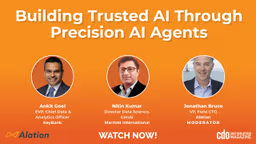Data Management
Seek Business Champions Who Understand Strategic Value of Data — North Dakota Information Technology CDO
Written by: CDO Magazine Bureau
Updated 8:42 PM UTC, Fri August 2, 2024
(US & Canada) Kim Weis, Chief Data Officer at North Dakota Information Technology, speaks with Bob Audet, Partner, Digital Solutions — Data at Guidehouse, in a video interview about the importance of data in building the AI strategy, best practices while developing the data strategy, proof of concepts, and delivering quick values to keep the momentum.
Weis begins by stating that North Dakota Information Technology has specifically laid the groundwork for defining its AI strategy along with its focus on a statewide data strategy. She notes that when the state realigned a year ago to better support AI, it brought together the automation, data science, and analytics teams to form an AI team.
The strategy development began there, says Weis, and as the AI strategy was drafted, the agency also delved much deeper into the data strategy initiative. While working with AI and GenAI, it is critical to understand and be educated on the type of data that can be used, she adds.
Highlighting the various risk categories, Weis shares that the agency started some of its data efforts with just a data classification policy before initiating any data strategy. She maintains that this led to the realization that teams need to be educated on low, moderate, and high-risk data.
Additionally, the teams should also know what kind of data can be utilized and fed to the publicly available GenAI solutions. Therefore, she stresses the cruciality of building a solid foundation.
Further, Weis emphasizes that AI remains a vital part of the development of the data strategy roadmap. She affirms the need to prioritize and execute AI-specific projects, which again calls for data and AI strategy alignment, looking through an operating model to support AI services from a central IT perspective, but also empowering the agency to do that from an AI policy perspective.
Weis reports that as a state, it has published an AI policy in early 2024, which will be part of the state’s execution of its data strategy. She asserts that both data and AI strategy could not be done in tandem, but that did not halt the efforts to work towards the AI piece. Weis reiterates that data is a prerequisite for what the team does.
Shedding light on the best practices while developing data strategy, she highlights finding business champions who understand the strategic value of data beyond transactional aspects. Also, that should be maintained across the board and throughout the organization.
Having such business champions who can advocate and educate has been helpful for Weis, who refers to them as “diamonds in the rough.” Next, she recommends starting with data literacy to start changing the culture and conversation.
Apart from educating stakeholders and business partners, Weis stresses the importance of speaking in business-friendly terms. She notes that it is necessary to speak to stakeholders in business-friendly language and meet them where they are in the journey.
Across the agencies, Weis states that the team has a broad distribution of knowledge maturity because the stakeholders might be ready for one thing but not the other. Therefore, the agency brings them in and engages them where they can and where it makes sense, and they can see the valuable quick wins.
The last piece is collaboration, partnership, and building trusted relationships between IT, data, and the business world if one wants to execute a successful data strategy.
When asked to share proof of concepts of vendor collaboration, Weis states that the agency had done a proof of concept before calling in the vendor. The use case involved two key agencies: the Department of Health & Human Services and the Department of Public Instruction, wherein the internal team did the POC to show what the art of possible was.
The POC was done early on to get people to think differently about data, which then gained momentum. However, throughout the journey, the conversations with agencies revolved around the use cases and struggles they face.
Thereafter, as the agency looks to build its implementation roadmap to support data strategy, analytic POCs have to be a part of it. She continues that if the agency wants to move in a direction to create, involve, and mature a modern data culture, POCs must be in place.
In conclusion, Weis states that it is imperative to keep the momentum going for the agencies, and delivering a quick win is a big part of it. She notes that at times, business folks lose interest in governance talks, and then putting immediate value in their hands works.
CDO Magazine appreciates Kim Weis for sharing insights on her data strategy with our global community.






